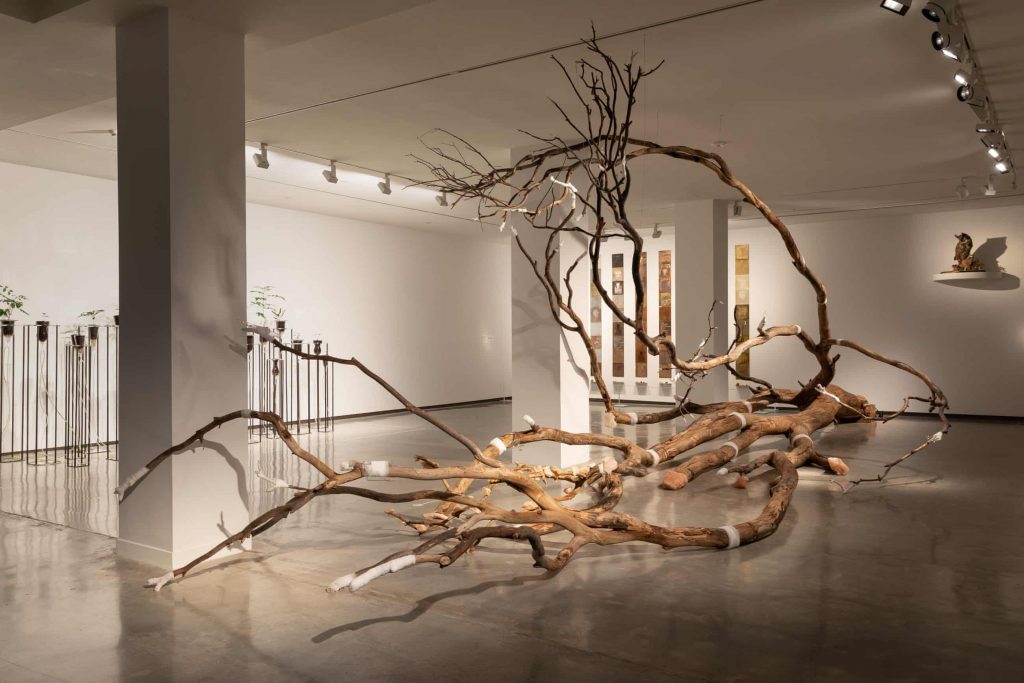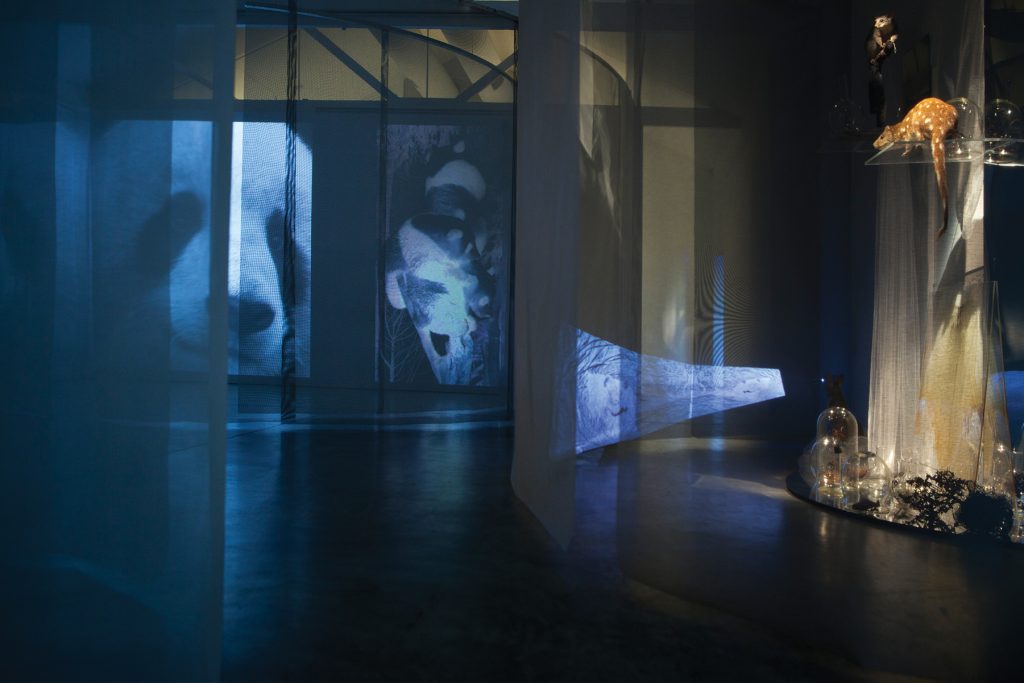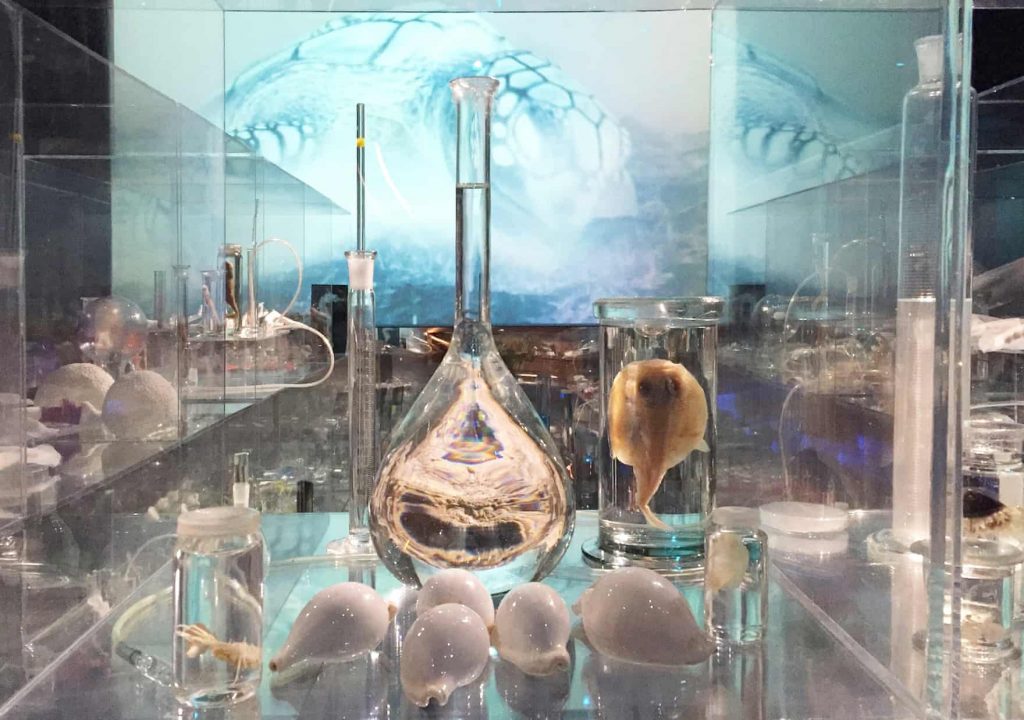Janet Laurence: After Nature, Museum of Contemporary Art Australia, Sydney, 1 March – 10 June 2019

As usual, I took in a few exhibitions on recent trip to Sydney. It was really fortunate that the visit coincided with this retrospective, plus a major new work, at the MCA. I wasn’t familiar with Laurence‘s work (though I now do remember her installation at Changi Airport in Singapore), but it is clear that there is a substantial overlap with a number of emerging themes in the development of my own work, albeit in a very different context, and with a very different emphasis. Engaging with, and reflecting on, Laurence’s work has enabled me to make a number of bridges and connections between aspects of both my visual and conceptual work. I’ll summarise these here, in relation to the exhibition, and will return to the themes in the development of my work over the coming weeks. In particular, the exhibition, and subsequent reading about Laurence’s work, has enabled me to think more clearly about the form that the outcomes of my final major project might take, and how this relates to my methodology and broader conceptual framework.

This exhibition includes key works by Laurence, from early pieces using metal plates, minerals, organic substances and photographs mounted on lightboxes (exploring, for instance, the periodic table), through installations from the 2000s featuring plant and animal specimens and ‘wunderkammer’ (box of curiosities) environments, to a contemporary commissioned piece, featuring floor to ceiling ‘veils’ printed with tree images, arranged in three concentric rings through which visitors can walk, and quasi-scientific collections of plant samples and apparatus (a herbarium, an elixir bar and a botanical library). As the curator’s notes state, Laurence explores ‘the interconnection of all living things – animal, plant, mineral – through a multi-disciplinary approach’ using ‘sculpture, installation, photography and video’ (Kent, 2019, online) . As Gibson (2015a) notes, Laurence has a ‘biocentric’ view of the world, and that, through incorporation of live biotic material in her work, she goes beyond just the entanglement of the human and the (other non-human) natural to focus on questions of care and the possibility of repair and reparation.

Gibson and Laurence (2015) explore the relationship between this work and contemporary post-humanist theory (and this is further explored by Gibson, 2015a and 2015b). Focusing on the piece Fugitive (2013) they argue that Laurence entangles the (human) viewer in the natural, making us all complicit in ecological/environmental decline, but, in the light of Barad’s non-dualist ontology, whilst shifting the human from the centre, resists re-assertion of a culture/nature divide. The collection of organic and animal material, and the multi-modal form, subverts scientific objectivity whilst questioning human subjectivity.
Citing Barad (2012) and Harraway (2004), they state that
‘The reason Karen Barad is so helpful in a discussion of Laurence’s artwork, that deals with human ruination of nature and re-performances that might create a new emergent force, is that she warns against simply inverting humanism, in order to avoid anthropocentrism. She warns against blurring boundaries between human and non- human in an effort to equalize ontology. These cautions are also iterated by Donna Haraway’s discussions of leaky distinctions between human, animal and machine. Haraway says, ‘Movements for animal rights are not irrational denials of human uniqueness; they are clear-sighted recognition of connection across the discredited breach of nature and culture…the boundary between physical and non-physical is very imprecise for us. (Haraway, 2004: 10-11)’’ (Palmer & Laurence, 2015: 46-7).
Central to this work is Barad’s idea of ‘intra-action’. As Palmer and Laurence (2015) state
‘The matter is there in the forceful enactment. The reason Barad’s concept of intra-action is so exciting is because her quantum physics expertise develops into an exploratory elaboration of this idea into the realm of phenomenology. In other words, she sees phenomena as quantumly entangled, but this is not individual entities becoming entangled but where intra-acting components are inseparable or indivisible. Perhaps, the entities don’t come together and become entangled, they already were entangled primordially’. (47)
Laurence produces places where crossing-over can take place, where difference can be questioned and entanglement experienced. There is also a sense of slowing down and focusing of attention when presented by the sheer volume, and forms, or artefact, both veiled and brightly illuminated. As Miall (2019) notes, this effect is particularly marked in Laurence’s site specific works,
‘The spatiality of installations, their insistence on embodied contemplation and the way in which they engender a haptic, bodily awareness through overlaying the processes of memory and perception with the work’s materiality, are central to the transformative experience of Laurence’s public projects’. (86)

Engaging with Laurence’s work has influenced my own thinking in a number of ways. It has helped me to think more clearly about the link between post-humanist theory and art, as it relates to the kinds of contexts I am exploring. She highlights the co-dependence of the human and the natural and the reciprocity of care (which in turn, and in intention, undermines the human/natural dualism). Post-humanism is not anti-humanism, and, for me, the challenge, artistically, is to explore the de-centring of the human whilst maintaining an active commitment to equity and social justice. There is no necessary tension between non-anthropocentric view and a ‘good life’, in fact, for the latter to be sustainable the former is a necessity. The experience of Laurence’s work has given me some insight into how I might provide a sense of entwinement of individuals and communities in place, and the alienating nature of contemporary developments. This enriches the insight provided by more sociological analyses of urban development (like Klinenberg’s, 2018, studies of social infrastructure) , and provides a bridge to the neuroscience influenced work of Fitzgerald et al (2018 & 2016), which brings us back, by a different route, to the entanglement of the human and the natural in the ‘neuropolis’.

References
Barad, K. 2012. ‘Nature’s Queer Performativity.’ Kvinder, Køn og forskning/ Women, Gender and Research. No. 1-2: 25-53.
Fitzgerald, D., Rose, N. and Singh, I. 2018. ‘Living Well in the Neuropolis’, The Sociological Review, 64: 221–237.
Fitzgerald, D., Rose, N. and Singh, I. 2016. ‘Revitalizing sociology: Urban life and mental illness between history and the present’, British Journal of Sociology, 67(1): 138–160.
Gibson, P. and Laurence, J. 2015 ‘Janet Laurence: Aesthetics of Care’, Antennae: The Journal of Nature in Visual Culture, (31): 39–52.
Gibson, P. 2015a. ‘Plant thinking as geo-philosophy’, Transformations: Journal of Media & Culture, (26): 1–9. Available at: http://www.transformationsjournal.org/journal/26/02.shtml.
Gibson, P. 2015b. Janet Laurence: The Pharmacy of Plants. Sydney: NewSouth Books.
Haraway, D. 2004. The Haraway Reader. New York, Routledge.
Kent, R. 2019. After Nature: Janet Laurence. Online at https://www.mca.com.au/artists-works/exhibitions/829-janet-laurence/ [accessed 02.01.19].
Klinenberg, E. 2018. Palaces for the People: How to Build a More Equal and United Society. London: Bodley Head.
Miall, N. 2019 ‘The Constant Gardener: On Janet Laurence’s Site-Specific Works’, in Kent, R. (ed.) Janet Laurence: After Nature. Sydney: Museum of Contemporary Art Australia: 83–95.
